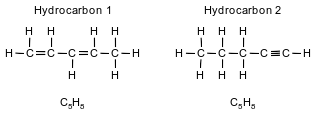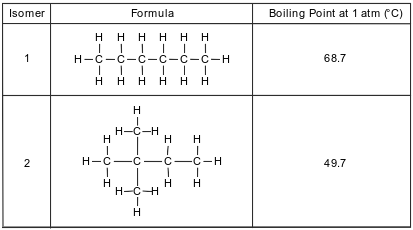Topic: Hydrocarbons
Hydrocarbons
Which compound is classified as a hydrocarbon?
(1) butanal
(2) butyne
(3) 2-butanol
(4) 2-butanone
Which formula represents an unsaturated hydrocarbon?
(1) C2H4
(2) C3H8
(3) C4H10
(4) C5H12
Which compound is saturated?
(1) butane
(2) ethene
(3) heptene
(4) pentyne
Which formula represents an unsaturated hydrocarbon?
(1) CH4
(2) C2H4
(3) C3H8
(4) C4H10
Which formula represents an unsaturated hydrocarbon?
(1) 
(2) 
(3) 
(4) 
How many pairs of electrons are shared between two adjacent carbon atoms in a saturated hydrocarbon?
(1) 1
(2) 2
(3) 3
(4) 4
Hydrocarbons are composed of the elements
(1) carbon and hydrogen, only
(2) carbon and oxygen, only
(3) carbon, hydrogen, and oxygen
(4) carbon, nitrogen, and oxygen
Which hydrocarbon is saturated?
(1) C2H2
(2) C3H4
(3) C4H6
(4) C4H10
Which formula represents a hydrocarbon?
(1) CH3I
(2) CH3NH2
(3) CH3CH3
(4) CH3OH
Two hydrocarbons that are isomers of each other are represented by the structural formulas and molecular formulas below.

Explain, in terms of bonds, why these hydrocarbons are unsaturated.
Allow 1 credit. Acceptable responses include, but are not limited to:
• A hydrocarbon 1 molecule has two carbon-carbon double bonds and a hydrocarbon 2 molecule has one carbon-carbon triple bond.
• Both hydrocarbons have at least one multiple covalent bond between two carbon atoms.
The equation below represents the reaction between 1-butene and bromine to form the compound 1,2-dibromobutane, C4H8Br2.

Explain, in terms of bonding, why the hydrocarbon reactant is an unsaturated hydrocarbon.
Allow 1 credit. Acceptable responses include, but are not limited to:
• Each reactant hydrocarbon molecule has a double carbon-carbon bond.
• There is a multiple carbon-carbon bond in each molecule.
• More hydrogen atoms can be bonded with this hydrocarbon.
The diagrams below represent ball-and-stick models of two molecules. In a ball-and-stick model, each ball represents an atom, and the sticks between balls represent chemical bonds.

Explain, in terms of carbon-carbon bonds, why the hydrocarbon represented in diagram B is saturated.
Allow 1 credit. Acceptable responses include, but are not limited to:
• The molecule in diagram B has only single carbon-carbon bonds.
• There are no multiple bonds between the carbon atoms.
• Cannot add more H atoms to the C atoms because all C−C bonds are single.
Natural gas and coal are two fuels burned to produce energy. Natural gas consists of approximately 80% methane, 10% ethane, 4% propane, 2% butane, and other components.
The burning of coal usually produces sulfur dioxide, SO2(g), and sulfur trioxide, SO3(g), which are major air pollutants. Both SO2(g) and SO3(g) react with water in the air to form acids.
Write the general formula for the homologous series that includes the components of the natural gas listed in this passage.
Allow 1 credit for CnH2n+2.
Crude oil, primarily a mixture of hydrocarbons, is separated into useful components in a fractionating tower. At the bottom of the tower, the crude oil is heated to about 400°C. The gases formed rise and cool. Most of the gases condense and are collected as liquid fractions. The table below shows the temperature ranges for collecting various hydrocarbon fractions.

Determine the number of carbon atoms in one molecule of an alkane that has 22 hydrogen atoms in the molecule.
Allow 1 credit for 10 or ten.
There are several isomers of C6H14. The formulas and boiling points for two of these isomers are given in the table below.

Identify the homologous series to which these isomers belong.
Allow 1 credit. Acceptable responses include, but are not limited to:
• alkanes
• CnH2n+2
